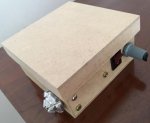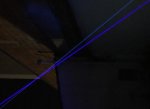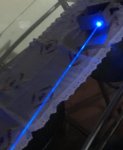- Joined
- Jun 22, 2011
- Messages
- 2,431
- Points
- 83
[Warning: pic heavy!]
Here's my latest build. It is, by far, the coolest laser in my collection.
There have been a few similar builds before, mine isn't fancy but I hope you'll enjoy it!
I really like lasers in boxes as long as they are still portable. That's the case here, it can still be carried around and has the obvious advantages of boxes: stands on it's own with no chance of rolling, easy to build, has space for a modulating pot.
Specs:
Diode: NDB7675
Driver: BlackBuck 8M
Current: 0-2.8A controlled by an external pot while the laser is on
Lens: 3 element
Approximate wavelength: 462-476nm
Power:0-1.5W (it peaks around 2A and then folds back to 1.1W at 2.8A and keeps dropping, can't leave it on at that current very long)
This isn't a very efficient diode but it's higher wavelength than my other NDB7675 even at lower currents.


The tape is used to pull the batteries from the holder.
I measured wavelength using my ghetto spectrometer (a cheap spectroscope glued to a webcam). The second, weaker line is a 473nm DPSS for comparison. My spectrometer is obvisouly not precise, but at max current the laser is clearly above 473nm. Here are the readings at multiple current settings:



Note that the pictures below serve to show the wavelength variation, but the actual color looks nothing like the pictures. At low power the beam looks royal blue with maybe a very slight touch of violet, then it goes to a pure, cobalt blue. At max current it looks light bluish-green, not cyan. ZRaffleticket's picture here is actually closer to the beam color. The dot color remains blue throughout, but gets lighter as it goes.
Here's some comparison shots at multiple currents:



Here's my latest build. It is, by far, the coolest laser in my collection.
There have been a few similar builds before, mine isn't fancy but I hope you'll enjoy it!
I really like lasers in boxes as long as they are still portable. That's the case here, it can still be carried around and has the obvious advantages of boxes: stands on it's own with no chance of rolling, easy to build, has space for a modulating pot.
Specs:
Diode: NDB7675
Driver: BlackBuck 8M
Current: 0-2.8A controlled by an external pot while the laser is on
Lens: 3 element
Approximate wavelength: 462-476nm
Power:0-1.5W (it peaks around 2A and then folds back to 1.1W at 2.8A and keeps dropping, can't leave it on at that current very long)
This isn't a very efficient diode but it's higher wavelength than my other NDB7675 even at lower currents.
The tape is used to pull the batteries from the holder.
I measured wavelength using my ghetto spectrometer (a cheap spectroscope glued to a webcam). The second, weaker line is a 473nm DPSS for comparison. My spectrometer is obvisouly not precise, but at max current the laser is clearly above 473nm. Here are the readings at multiple current settings:
Note that the pictures below serve to show the wavelength variation, but the actual color looks nothing like the pictures. At low power the beam looks royal blue with maybe a very slight touch of violet, then it goes to a pure, cobalt blue. At max current it looks light bluish-green, not cyan. ZRaffleticket's picture here is actually closer to the beam color. The dot color remains blue throughout, but gets lighter as it goes.
Here's some comparison shots at multiple currents:
Attachments
Last edited:



















